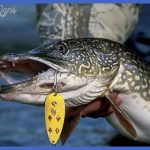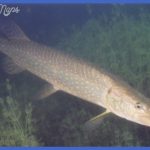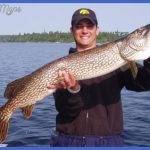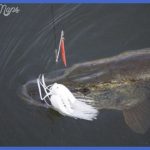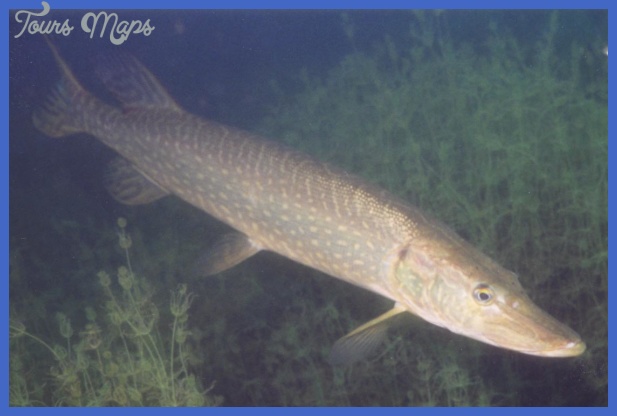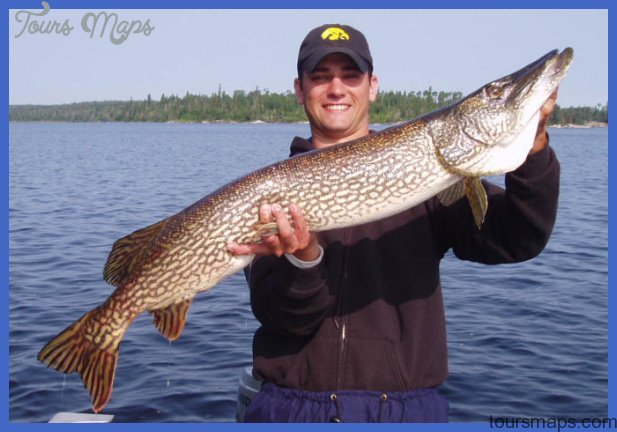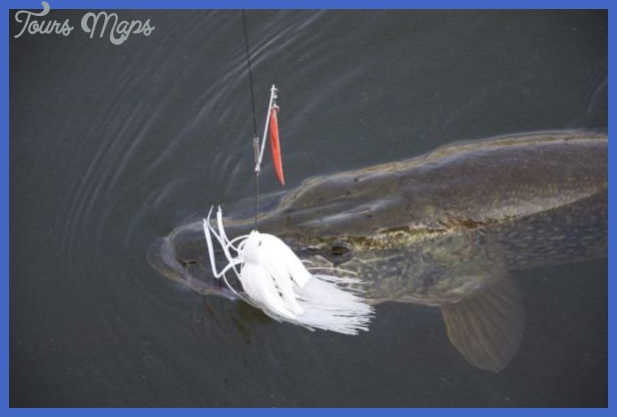Northern pike, Esox lucius, exist in Maine through unsanctioned introduction. When pike began showing up in the Belgrade Lakes region, anglers worried that these efficient predators would raise havoc with existing fish populations. This has not happened. Instead, pike have made a place for themselves without threatening the trout, bass, and landlocked salmon.
Pike are voracious feeders, able to eat almost anything that is not more than half their size. The catholic appetite of pike is responsible for the demise of large numbers of ducklings each year, as well as muskrats and frogs. Other victims can include bragging-size bass, trout, pickerel, yellow perch, and other pike.
Pike are happiest when the water temperature is between 45 and 60 degrees. In Maine, water temperatures on the surface do not get above 60 degrees until sometime in May, but underwater temperatures can remain cooler for a longer period. Pike fishing is slow in summer. The warmer temperatures slow down the pike’s biological processes, making them eat less.
Although you might pick up a pike anywhere in the lake, weed beds seem to be their favorite hangouts. Schools of bait fish, which pike feed on, use weed beds as protective cover. Pike will sit motionless near a prime spot, then attack when a hapless bait fish (or anything else) swims by.
Pike are not nocturnal, as are bass and trout, nor do they bite well in the middle of a bright, sunny day. Peak feeding times are mid-morning and mid-afternoon.
Pike grow large in Maine, as witnessed by the 26.74-pound state record. Given a pike’s potential for growth, this record is destined to be broken someday. Maybe you will be the angler to do just that.
Techniques
Spin fishing – Use medium to heavy spinning rods and reels. Light tackle has no place in pike fishing, since you need plenty of power to wrestle large pike out from weeds and other snags.
Large spinners, spinner baits, buzz baits, Rapalas, and large spoons are all good pike producers. Use at least a 10- or 12-pound test line and a short wire leader. The leader is needed to keep the pike’s needle-like teeth from severing your line.
If you can locate an underwater weed bed, here is a good way to fish it. Using large spinners, cast over the weed bed and begin counting as you allow your lure to sink. When it hits the weeds, stop counting. If you had a count of 15, for instance, all you need to do is cast again, count to 12 or 13, and begin reeling. This allows you to pull your lure just over the tops of the weeds, which is where pike will be waiting. Aquatic weeds, like all other weeds, grow higher as the season progresses, so late spring and early summer will be the best times to employ this method.
When the weeds have grown above the water’s surface, you need to cast as close to them as you can. You can anchor off the weed beds and cast toward them in a ”wagon wheel” pattern, or you might actually tie off on the weeds and cast parallel to them. If you hook a big fish by the latter method, have a partner take the boat or canoe out to open water as soon as possible. Large spoons such as Johnson’s Silver Minnow and Daredevles are favorites for this type of fishing. Allow the spoon to flutter toward the bottom, then reel for a few feet and let the spoon flutter again.
Pike will also hit topwater offerings. Use the largest bass poppers you can find. To give you an idea of how large a topwater lure you can use, a special pike lure was once manufactured that was identical in size and shape to a duckling. You needed a powerful outfit to fish it, but it worked.
Fly casting – Fly fishers often abandon spring landlocked salmon fishing in order to tangle with a trophy pike. Make sure your reel has a smooth drag and load it with 100 yards of 18-pound test backing. Rods should be at least 8-weight, and weight-forward fly lines are best. You need a shock tippet of 50-pound test to take the place of a wire leader.
Aim your casts toward weed beds and on the shady side of any obvious structure. Use the largest, bushiest streamers you can find. Hook sizes of 2 and 3 are best. You can have success by using standard saltwater patterns, especially flies designed for striped bass such as Lefty’s deceiver and McNalley smelt.
Throwing a deer-hair bass bug to a waiting pike may be one of fly fishing’s greatest thrills. Mid-morning, mid-afternoon, and early evening are the best times for topwater action. If your shock tippet causes your bass bug to sink, you will have to dispense with it and hope your pike will be hooked in such a way that it cannot bite your line.
Bait fishing – Pike like large bait. Use a stout rod and reel, wire leader, a size 2 hook, and the largest golden shiner or sucker you can find. Any other large minnow will work, but suckers and golden shiners are best. You might want to use a bobber to keep your bait from getting wound up in the weeds. Adjust the bobber so the bait is at least 3 feet beneath the surface. Cast the baited hook and bobber near a likely looking weed bed and let it sit. Allow your line to play out freely as the bait carries the bobber around. When a pike hits, the bobber will plummet as the fish dashes off with the bait.
You must make sure your line is perfectly tight before you strike. Holding your rod high, follow the fish with the rod. When you are ready to strike, lower the rod and point it at the fish. Then, when you feel pressure, strike as hard as you can.
Of course, if the pike heads for the weeds after it takes your bait, you have no choice but to strike fast and hope for the best.
Bait fishers can also take pike by slowly drifting a live minnow near bottom during the warmer months. A three-way swivel is helpful for this type of fishing. Attach one end of the swivel to your line. Attach a 2-foot section of the same pound test line to the second end of the swivel and tie a wire leader to it. Affix your hook to the leader. Now attach a 1-foot section of lighter line to the third end of the swivel. Attach a few split shot to the end of the weaker line. If the split shot get hooked on bottom, the lighter line will break, saving your hook.
As you drift, be ready to pay out line when a pike hits. For this reason, it is good to hold the rod in your hand rather than placing it in a rod holder.
Ice fishing – Northern pike have a huge following of hard water anglers. Use tip-ups, baited with large minnows. Fish near weed beds in from 10 to 20 feet of water. If you don’t take fish, you might change tactics by going into a shallow cove and fishing with small minnows in 5 to 10 feet of water. Pike sometimes take advantage of the shallows and their tiny resident bait fish.
Pike will hit ice jigs, but you need a stout rod. Use a medium-weight spinning reel with 15-pound test line and a short wire leader. Regulations on pike vary with different waters, so be sure to consult the rule book.
Best bets for Maine’s northern pike: Pike fishing is pretty much limited to the Belgrade Region’s chain of ponds. Try these for both open water and ice fishing: Great Pond and Long Pond, Site 11; and North Pond, Site 12.
Fishing: Northern Pike Photo Gallery
Maybe You Like Them Too
- The Best Cities To Visit in The World
- World’s 10 Best Places To Visit
- Coolest Countries in the World to Visit
- Travel to Santorini, Greece
- Map of Barbados – Holiday in Barbados

